Since we receive some questions about our Japanese green teas, I thought it would be a great idea to list here FAQ about our Japanese green teas.
Q: Matcha green tea powder and Sencha green tea powder come in powder form but are they instant tea?
A: Not at all. Our Matcha Green Tea Powder and Sencha green tea powder are intentionally grounded finely from tea leaves so that you can ingest 100% of the nutritions of tea leaves, while you can only take 20% of nutrition from infused tea.
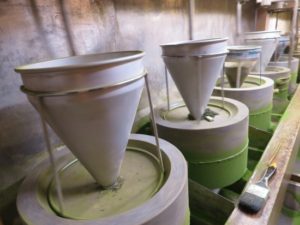
Q: What is the difference between Matcha green tea powder and Sencha green tea powder?
Matcha Green tea powder and Sencha Green tea powder come from the same plant Camellia sinensis but how they grow and how they processed are different, thus the taste and the benefits differ.
<Taste>
A: If you are used to drink green tea, Sencha green tea powder has similar taste but it’s much tastier since it is finely grounded tea leaves. Matcha has more veggie taste and sweet due to Amino acid.
<Texture and color>
A: Sencha green tea powder is finer and it can be dissolved in cold water too. Matcha green tea powder needs to be whisked or blended in the blender so ideal to add it to your smoothies. Sencha’s green is lighter and less vibrant than Matcha.
<Nutrition fact>
A: Both Matcha and Sencha are loaded with antioxidants but Matcha grows in the shade for the last month before harvest so it has more chlorophyll – great for detox and amino acid L-Theanine – calming agent so it makes you relax, helps you concentrate and removes stress. Sencha stays in the sun until harvest so L-Theanine becomes catechin (antioxidents) which is anti-inflammatory, anti-bacterial property, so it helps you stay away from cold, burn calories, boost metabolism, control cholesterol and prevent tumor growth, lower blood pressure etc.
<Price>
A: Matcha is more expensive because the process is more elaborated. The tea leaves are covered in the shade for a month before the harvest and hand picked, while the tea leaves for Sencha are not covered and they use scissors or machines to cut the leaves.
We also got the feedback from people who visited Tokyo that they were served with Sencha in Sushi bar of Tokyo! One thing we can say is our sencha is definately better as it’s grown in Uji of Kyoto which is renown for the best tea in Japan and most importantly it is organic 🙂
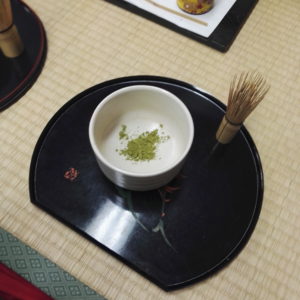
Q: I found cheaper Matcha Green Tea
A: That’s because our Matcha grows and processed in Japan. If you find cheaper, the origin is not from Japan. To have a good quality Matcha, growing in right environment is very important. Also it needs to follow certain process to make Tencha (name of teas before grounded). The process includes covering leaves from the sun 30 days before harvest, handpicking (not by scissors or machines), steamed and dried. When Tencha is ready it will be finely grounded and it becomes Matcha. This process is very important to produce a good quality Matcha. On the contrary we also get feedback that our Matcha is reasonable. We priced our Matcha reasonably in order for you to include in your daily diet. Our Matcha is a every day Matcha (not for tea ceremony) because if it is too expensive you will use only a few times in a month and you might end up leaving it in your cupboard. We don’t want this to happen to you because we want you to get good results by taking this nutritions regularly.
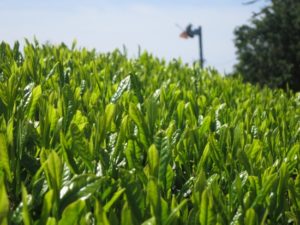
Q: What is Genmaicha?
Genmai means brown rice in Japanese. Genmaicha is sencha green tea leaves with toasted browne rice so it has nutty flavour. Our Genmaicha also contains a bit of Matcha powder. In the summer months, you can also prepare it with cold water. It takes 3 hours to have the same taste as you brew it with hot water but vitamin C and l-theanine appear in the water without breaking. You can prepare it in a tea pot and leave it in the fridge so you can take a few cups in a day 🙂 Believe me it is so fresh and tasty!
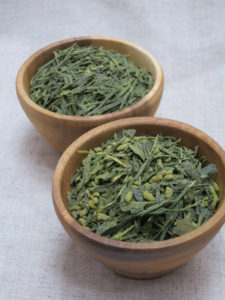
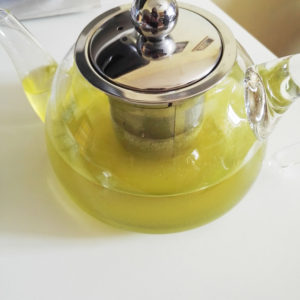
Q: Your green tea is so green!
A: Yes, a good quality green tea should have this color! If the color becomes brown when you brew tea, that’s not a good quality green tea. That is because the leaves are oxidized. When the green tea is oxidized, one of the antioxidants EGCGs (burns calories, controls cholesterol, prevent tumor growth and lower blood pressure and etc) degrades so you cannot benefit from it. The picture below, the left one is an ordinary supermarket green tea bag and you can see that it is brown. According to a study by a famous French web-site “UFC que choisir“, the ordinary green tea teabags also contain some unwanted substances such as other grasses which accidentaly came in when harvesting as well as PAHs as shown in the next question.
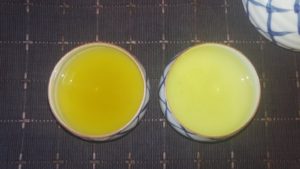
Q: I heard that there is Polycyclic aromatic hydrocarbons (PAHs) in green tea. Is it true?
This is not the case in Japanese green tea because in Japan, for the tea leaves not to become oxidized, they are steamed. The world’s biggest produce of green tea is China and that is 80%. They use a a different method for the tea leaves not to become oxidiezed. The tea leaves are cooked in the oven and coal is used to cook them, then Polycyclic aromatic hydrocarbons are released and remains in the tea bags.
Shop our Japanese green teas from here